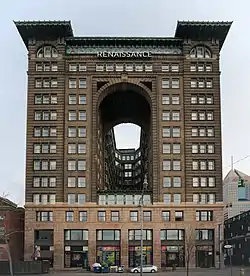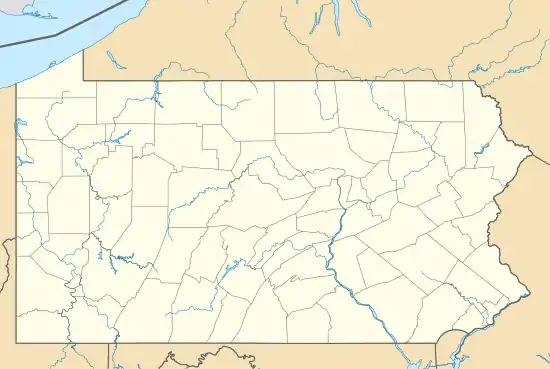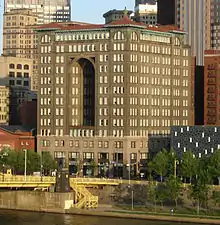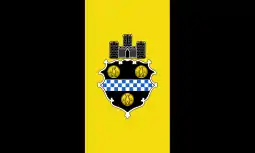Fulton Building | |
 | |
   | |
| Location | 107 Sixth St., Pittsburgh, Pennsylvania |
|---|---|
| Coordinates | 40°26′38″N 80°00′08″W / 40.4438°N 80.0023°W |
| Area | less than one acre |
| Built | 1906 |
| Architect | Grosvenor Atterbury |
| Architectural style | Italian Renaissance |
| NRHP reference No. | 02000556 [1] |
| Significant dates | |
| Added to NRHP | May 10, 2002 |
| Designated PHLF | 2003[2] |
The Fulton Building is an historic structure in Pittsburgh, Pennsylvania. Named after inventor Robert Fulton, the building was designed by architect Grosvenor Atterbury and completed in 1906. Construction was funded by industrialist Henry Phipps.[3]
History and features

The Fulton Building as seen from across the Allegheny River
Completed in 1906, the building was designed by architect Grosvenor Atterbury. Its construction was funded by industrialist Henry Phipps. It was subsequently named after noted inventor Robert Fulton.[4]
On May 26, 1943 the building hosted America's first night-court for gasoline war ration violators.[5]
Since 2001, it has been the home of the city's Renaissance Hotel.[6]
It was listed on the National Register of Historic Places in 2002.[1]
References
Wikimedia Commons has media related to Fulton Building.
- 1 2 "National Register Information System". National Register of Historic Places. National Park Service. March 13, 2009.
- ↑ Historic Landmark Plaques 1968-2009 (PDF). Pittsburgh, PA: Pittsburgh History & Landmarks Foundation. 2010. Retrieved 2011-07-28.
- ↑ Lowry, Patricia. "Renovated Fulton Building opening as Renaissance Pittsburgh Hotel." Pittsburgh, Pennsylvania: Pittsburgh Post-Gazette News, March 13, 2001.
- ↑ Lowry, "Renovated Fulton Building opening as Renaissance Pittsburgh Hotel," Pittsburgh Post-Gazette News, March 13, 2001.
- ↑ "Request Rejected".
- ↑ Lowry, "Renovated Fulton Building opening as Renaissance Pittsburgh Hotel," Pittsburgh Post-Gazette News, March 13, 2001.
This article is issued from Wikipedia. The text is licensed under Creative Commons - Attribution - Sharealike. Additional terms may apply for the media files.


